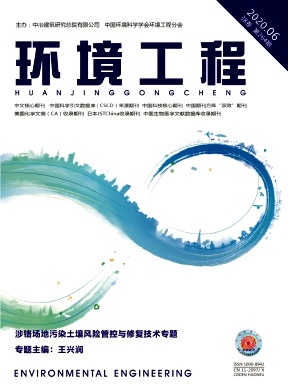|
VARJANI S J. Microbial degradation of petroleum hydrocarbons [J]. Bioresource Technology, 2017, 223: 277-286.
|
|
李宝明. 石油污染土壤微生物修复的研究[D]. 北京: 中国农业科学院, 2007.
|
|
张学佳,纪巍,康志军,等. 石油类污染物对土壤生态环境的危害[J]. 化工科技, 2008, 16(6): 60-65.
|
|
CHANDRA S, SHARMA R, SINGH K, et al. Application of bioremediation technology in the environment contaminated with petroleum hydrocarbon [J]. Annals of Microbiology, 2013, 63(2): 417-431.
|
|
MECKENSTOCK R U, BOLL M, MOUTTAKI H, et al. Anaerobic degradation of benzene and polycyclic aromatic hydrocarbons [J]. Journal of Molecular Microbiology and Biotechnology, 2016, 26(1/2/3): 92-118.
|
|
ZHANG Z Z, HOU Z W, YANG C Y, et al. Degradation of n-alkanes and polycyclic aromatic hydrocarbons in petroleum by a newly isolated Pseudomonas aeruginosa DQ8[J]. Bioresource Technology, 2011, 102(5): 4111-4116.
|
|
COSTA A S, ROMAO L P, ARAUJO B R, et al. Environmental strategies to remove volatile aromatic fractions (BTEX) from petroleum industry wastewater using biomass [J]. Bioresource Technology, 2012, 105: 31-39.
|
|
SOUZA E C, VESSONI-PENNA T C, Oliveira R P S. Biosurfactant-enhanced hydrocarbon bioremediation: An overview [J]. International Biodeterioration & Biodegradation, 2014, 89: 88-94.
|
|
杜亚鲁, 胡韬, 彭琳. 土壤石油污染的生物修复技术研究进展[J]. 环境科学与技术, 2017, 40(增刊1): 133-138.
|
|
ABBASIAN F, LOCKINGTON R, MALLAVARAPU M, et al. A comprehensive review of aliphatic hydrocarbon biodegradation by bacteria [J]. Applied Biochemistry Biotechnology, 2015, 176(3): 670-699.
|
|
WILKES H, BUCKEL W, GOLDING B T, et al. Metabolism of hydrocarbons in n-alkane-utilizing anaerobic bacteria [J]. Journal of Molcular Microbiology and Biotechnology, 2016, 26(1/2/3): 138-151.
|
|
GHAZALI F M, RAHMAN R N Z A, SALLEH A B, et al. Biodegradation of hydrocarbons in soil by microbial consortium [J]. International Biodeterioration & Biodegradation, 2004, 54(1): 61-67.
|
|
JANBANDHU A, FULEKAR M H. Biodegradation of phenanthrene using adapted microbial consortium isolated from petrochemical contaminated environment [J]. Journal of Hazardous Materials, 2011, 187(1/2/3): 333-340.
|
|
MITTAL A, SINGH P. Isolation of hydrocarbon degrading bacteria from soils contaminated with crude oil spills [J]. Indian Journal of Experimental Biology, 2009, 47(9): 760-765.
|
|
HARAYAMA S, KASAI Y, HARA A. Microbial communities in oil-contaminated seawater [J]. Current Opinion in Biotechnology, 2004, 15(3): 205-214.
|
|
赵晓秀, 赵慧敏, 全燮, 等. 石油污染土壤中菲、蒽和正十六烷的微生物降解[J]. 生态学杂志, 2009,28(3):456-460.
|
|
钱奕忠. 微生物降解石油废水的研究[D]. 北京: 北京化工大学, 2001.
|
|
朱杰, 阮志勇,董卫卫,等. 一株高效烷烃降解菌Acinetobacter sp.LAM1007的分离鉴定及降解特性[J]. 微生物学通报, 2017,44(7):1535-1546.
|
|
温文静, 谭丽婵, 雒晓芳, 等. 嗜碱性假单胞菌对菲的降解研究[J]. 西北民族大学学报(自然科学版), 2016,37(3):58-61.
|
|
徐成斌, 王闻烨, 李鲜珠, 等. 一株菲降解菌的鉴定及降解特性[J]. 环境科学学报, 2015, 35(3):684-691.
|
|
杨乐. 产表面活性剂解烃菌的筛选及其降解条件研究[J]. 环境工程, 2015(6):153-157.
|
|
LIU Y, ZENG G M, ZHONG H, et al. Effect of rhamnolipid solubilization on hexadecane bioavailability: enhancement or reduction? [J]. Journal of Hazardous Materials, 2017, 322(Pt B): 394-401.
|
|
INōS, MNIF, DHOUHA G. Glycolipids biosurfactants; potential related biomedical and biotechnological applications[J]. Carbohydrate Research, 2015.
|
|
李敬龙, 刘晔, 潘爱珍. 生物表面活性剂及其应用[J]. 齐鲁工业大学学报, 2004, 18(2):41-46.
|


 Login
Login Register
Register E-alert
E-alert






 DownLoad:
DownLoad: